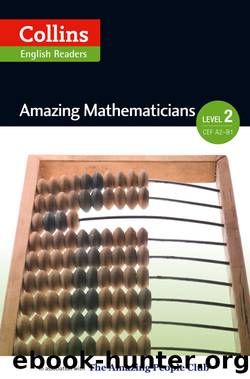Amazing Mathematicians by Anna Trewin

Author:Anna Trewin [Trewin, Anna]
Language: eng
Format: epub
ISBN: 9780007557004
Publisher: HarperCollins Publishers
Published: 2014-04-16T00:00:00+00:00
A heliotrope
In 1838, I received the Royal Societyâs Copley Medal â a prize given for important achievements in science. In 1840, I published my famous Dioptrische Untersuchungen which led to a difficult mathematical calculation called the âGaussian lens formulaâ. I never published my theories quickly â I always wanted to prove them first. Most people used intelligent guesses based on their experience. But I believed it was possible, with the correct information, to decide probability.
In 1849, I gave my famous âGolden Jubileeâ lecture to an audience of scientists and mathematicians. As a result, I received many kind messages from academics all over Europe. In my life Iâd greatly developed the subjects of mathematics, astronomy and physics and my methods became very important for surveying and measuring. In the years that followed my lecture, my health began to suffer. In 1855, I died in my sleep in Göttingen. I was 77 years old.
The Life of Carl Friedrich Gauss
1777 Carl Friedrich Gauss was born in Brunswick, Lower Saxony, Germany.
1780â1791 His genius for numbers was noticed by his teachers and Charles Ferdinand, the Duke of Brunswick.
1792 The Duke of Brunswick paid for Carl to go to the Collegium Carolinum.
1795 He went on to study at the University of Göttingen where he did important work on geometry and the theory of âquadratic reciprocity lawâ. He also became interested in prime numbers.
1799 He left university without a degree. In the same year he started writing Disquisitiones Arithmeticae. The book was a discussion of algebra.
1801 He published Disquisitiones Arithmeticae and found the position of the planet Ceres.
1804â1805 He was made a Fellow of the Royal Society of London. Carl married his first wife, Johanna Osthoff, and they later had three children.
1807 Carl was given the job of Professor at Göttingen University and Director of the Göttingen Observatory.
1809 His wife, Johanna, died giving birth to their second son. Their son died soon after.
1810 Carl married Johannaâs best friend, Minna Waldeck, and they had three children. He published the Theoria Motus Corporum Coelestium in Sectionibus Conicis Solem Ambientium.
1818â1832 Carl began measuring the land of Hanover. The work led to Carlâs invention of the heliotrope.
1820 Carl became a Fellow of the Royal Society, Edinburgh.
1831 His second wife died.
1833 He worked with Wilhelm Weber. They invented the telegraph device, which could send messages over a distance of 15,000 metres.
1838 He received the Royal Society of Londonâs Copley Medal.
1839 His mother died after a long illness.
1840 He published Dioptrische Untersuchungen which led to a calculation called the âGaussian lens formulaâ.
1849 He gave his Golden Jubilee lecture to an audience of mathematicians. As a result, he received kind messages from academics all over Europe.
1855 Carl Gauss died, aged 77, in Göttingen.
Download
This site does not store any files on its server. We only index and link to content provided by other sites. Please contact the content providers to delete copyright contents if any and email us, we'll remove relevant links or contents immediately.
Everything You Need to Ace Math in One Big Fat Notebook by Altair Peterson(752)
Grammar Secrets by Caroline Taggart(265)
The Boss of Everyone by Danny Wallace(237)
84 Amazing Maths Games to Boggle Your Brain! by Anna Claybourne(204)
Learn Russian Language Through Dialogue by Anna Tkachenko(203)
Search and Rescue Animals by Precious McKenzie(173)
Plus Magazine French Edition by F vrier 2023(172)
39 ESL Vocabulary Activities by Jackie Bolen(168)
A Field Guide to Goblins, Gremlins, and Other Wicked Creatures by Colin Ashcroft(164)
Digital Flash Cards--Times Tables Multiplication Facts by Devi Tan(156)
Bilingual Book in English and Portuguese by Colin Hann(155)
Using Climate Maps by Rebecca E. Hirsch(146)
Unusual and Awesome Jobs Using Math by Lisa M. Bolt Simons(139)
Let's Learn Tagalog Ebook by Imelda Fines Gasmen(138)
Channel Runner (Great Stories by Jeremy Taylor(136)
Forensic Psychologists by Jason Warr(133)
Hispanic America, Texas, and the Mexican War: 1835 - 1850 by James Lincoln Collier(126)
Fart-o-Pedia by Rip Van Ripperton(123)
Day of the Bizarros! by Benjamin Bird(121)
